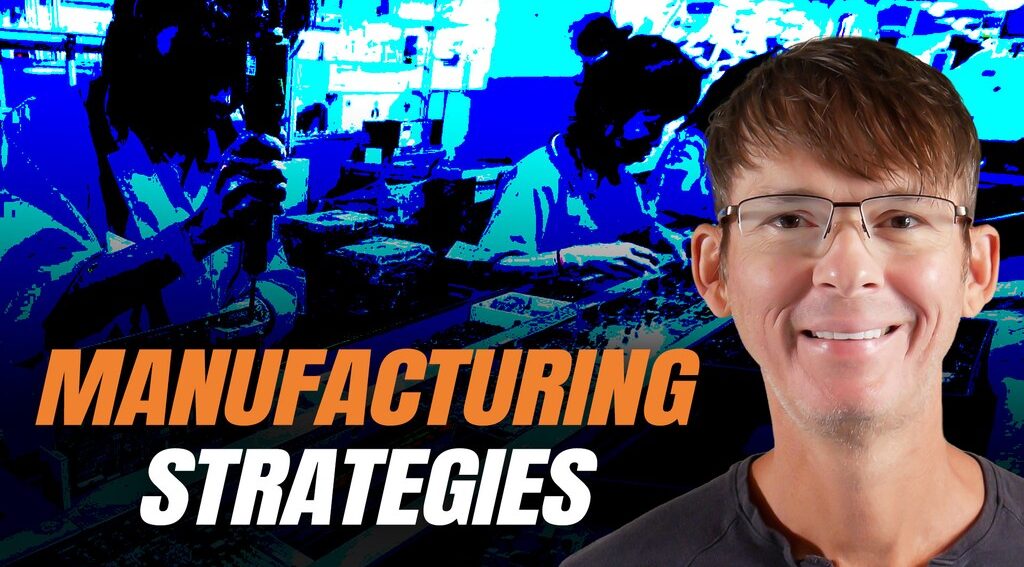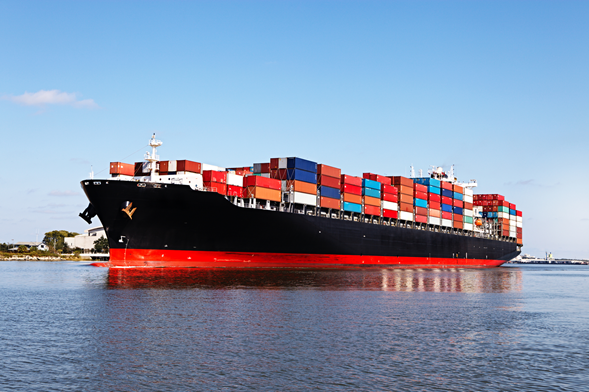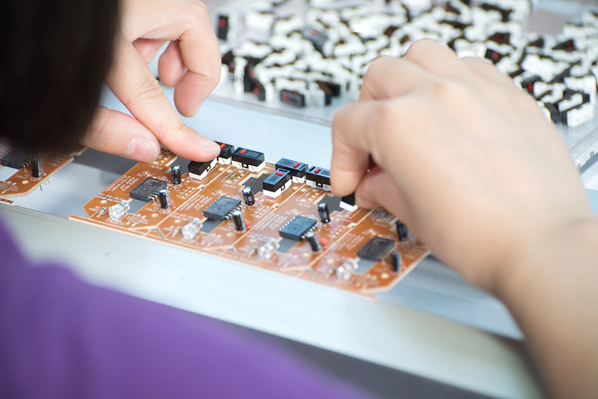How (and Where) to Manufacture Your New Electronic Product
We are going to compare three different manufacturing strategies: offshore, domestic, and hybrid manufacturing.

Once you’ve got a working prototype of your new product, you might be thinking you can just tell a manufacturer to make more of them, and you’re off to dominate the market.
Maybe you’re thinking, “How hard can it be to just make more of them?” Development was the hard part, right?
Well, I wish it was that easy, and that you could jump straight from a prototype to mass market success, but making a few prototypes is a whole lot different than mass producing thousands or millions of them!
So we’re going to look at three different manufacturing strategies for new hardware products once you’re ready to begin scaling up production.
Offshore Manufacturing
The first strategy I want to talk about is offshore manufacturing which for electronic products in most cases means China or Taiwan.
This option has the advantage of being the lowest-cost, but it is also the most challenging to properly oversee and manage.
This is because the factory is most likely on the other side of the world, with a huge time difference. It also means there are significant travel costs and complexities if you want to visit the factory in person.
With offshore manufacturing you don’t have a whole lot of control over the process, and you have little oversight since it’s so difficult to visit the factory.
Many times with Asian manufacturing it can also be challenging to even know if you are dealing directly with the actual factory, or with a 3rd-party middle person.
Although manufacturing in China or Taiwan will have the lowest cost it also carries the most potential risk and headaches.
In most cases, offshore manufacturing is going to be best once you’re at higher production volumes.
Additional considerations for the U.S.:
In 2019 the US imposed a tariff on electrical components and subassemblies imported from China.
But this tariff doesn’t apply to completely finished products, so if you’re in the U.S. you can avoid this tariff by doing the full product manufacturing offshore.
This tariff was initially as high as 15%, but the good news is that they started to decrease in 2020, and they began granting exemptions for a variety of electronic products, including some printed circuit boards.
However, they only apply to 2 and 4-layer rigid boards, and for now the tariff still applies to higher layer count boards, as well as to flex boards and specialized boards made from aluminum or ceramic.
This is a constantly evolving situation so be sure to check the latest status of these tariffs before making any manufacturing decisions.
I’d suggest working with your logistics company to help you accurately estimate the duties and tariffs specific for your product category.
One option to avoid this tariff is to do your manufacturing somewhere other than China.
Manufacturing in Taiwan is a good option because they have a sophisticated manufacturing infrastructure, and by manufacturing there you can bypass this tariff.
Being geographically close to China also means that Taiwanese manufacturers can easily source components from China.
You could also do offshore manufacturing in a country like India or Mexico.
However, in general, electronics manufacturing is predominantly done in Asia.
There are of course disadvantages to offshore manufacturing.
Some of these can be especially impactful in the early days of a startup, when production volumes are low.
Negatives to manufacturing in Asia
There are of course disadvantages to production in China. Some of these can be especially impactful in the early days of a startup, when production volumes are low. These include the following issues.
Quality control
You can have quality control problems regardless of where you manufacture your product. That being said, when you manufacture your product in a faraway location it is going to be a lot harder to monitor the manufacturing quality.
When quality control issues do pop up (trust me they will) its harder to resolve them given the time zone differences and language barriers.
You should also personally visit any factory that’s going to be making your product. One reason is to make sure your manufacturer in China isn’t just a 3rd party sourcing agent.
Although working with a sourcing agent isn’t necessarily a bad thing, you obviously need to know that they are taking a small piece of the profit.
Long shipping times
Manufacturing your product in China means that your product inventory starts off on the opposite side of the planet from where you need it, assuming you are in the US.
You have two options for shipping your product from China to the US – by air or by sea. Shipping your product by air is the quickest method but it is also the most expensive. These costs can cut into your profit margins significantly.
The heavier your product is, the more expensive it is to ship by air. It’s best to only ship small quantities of product by air, or when its absolutely essential.
Many years ago with my own product, I got a very nice sized order from Home Depot. But I had a big problem.
Home Depot wanted the order filled quickly, but I didn’t have enough inventory in my US warehouse to fill their order. I decided that in this case it made sense to ship by air, even though it would cost a lot more.
In general, you are going to ship most of your inventory by sea cargo. It is much, much cheaper than shipping by air. The downside is it is very slow. On average it takes about 3-4 weeks to ship your product by sea from China to a west coast port like Los Angeles.
However, recent supply chain problems mean that many shipping vessels are unable to dock and unload their cargo in a timely fashion. So, you will need to add extra time to your shipping estimates until COVID-19 related delays in global shipping are resolved.
Inefficient communication
Almost everyone you deal with professionally in China will speak English, but it is rare to work with a native English speaker. Although everyone I’ve dealt with in China can speak and write in English, there are a lot of scenarios where miscommunication can cause serious mishaps and delays.
The time difference between your location and China can also be a significant logistical issue, especially if you’re in the Western hemisphere. For example, 9:00 am EST is 10 pm in Beijing. Even email communication can have a lag time of 24 hours to get a reply.
Between the language barrier and the time difference, live phone calls can also become very problematic. In general, expect most of your communication to be limited to emails, especially when discussing technical details.
Everything takes longer
In general, everything takes much longer to do in China. That’s mainly because of the time zone differences, language barriers, and the physical distance.
But it is especially true when trying to debug any technical or manufacturing issues.
That’s why I typically recommend that you do your first manufacturing runs close to home. This way you can work out any bugs in your manufacturing and assembly processes.
Only once you have things running smoothly, should you transfer manufacturing over to China.
Domestic Manufacturing
The next option is domestic manufacturing, which means having the product manufactured in your own country. Most likely, you would import all the electronic parts.
Some parts may be available from domestic suppliers, but in general, a lot of them are going to be manufactured and shipped from China.
So if you are in the U.S. you’re going to have to pay that 25% tariff on all the components that you order even though you’ll be doing the manufacturing of the printed circuit board domestically.
Even excluding the tariffs, it’s going to be more expensive to manufacture domestically because everything ‒ most importantly, labor ‒ is more expensive in most countries than it is in China or Taiwan.
The big advantage to manufacturing domestically is it gives you more oversight. It’s much easier for you to visit the factory if it’s say, a few hours away by car or plane.
There are always going to be problems that come up during manufacturing, whether you are a small startup or a large company. Nothing ever runs perfectly from the start, and dealing with those issues domestically is going to be a lot simpler.
The level of oversight and convenience that you get with domestic manufacturing helps to ensure that you’re manufacturing and shipping quality products.
Of course, with offshore manufacturing you can still do quality checks without visiting the factory. You can have samples sent regularly, for instance.
However, manufacturing in a remote location, and communicating in a non native language, makes it harder to have effective oversight that ensures the quality of everything you produce.
You can take domestic manufacturing one step further by finding a manufacturer that’s more local to you ‒ in your city or at least in your state or province.
The big downside is that your choices are going to be a lot more limited if you restrict yourself to one local region.
Obviously, local manufacturing gives you even more ease of oversight.
Hybrid manufacturing
The last case, which is my favorite choice when you are starting off with low-volume manufacturing, is what I call hybrid manufacturing. This combines domestic with offshore manufacturing.
This is going to cost less because you’re getting the benefit of having some of the more expensive parts of the product manufactured offshore, in China or Taiwan, and you’re also going to have better oversight than with offshore manufacturing.
For example, you have your Printed Circuit Board and your product enclosure manufactured in China or Taiwan (by using Taiwan, you get around the US tariffs).
But, then you do the final product assembly, testing, packaging, and shipping domestically.
With hybrid manufacturing you have a couple options. My preferred option, initially, is for you and/or your team to do the product assembly yourselves. That works well for your first runs of hundreds of units.
This will give you the most insight because you’re the one actually doing the final assembly and testing of the product, ensuring that it meets all your quality control standards and that it is packaged and shipped correctly.
The benefits of this hybrid strategy are you still get the lower offshore price for your components, while still having in person oversight of the final stages of your product manufacturing. Your oversight will include the product assembly, testing, and packaging.
Note that even with a hybrid manufacturing strategy, you won’t be able to get around the 25% tariff if you’re importing either the parts or the sub-assemblies from China into the US. This is why I recommend looking at Taiwanese factories.
If you are restricted to Chinese manufacturers then you may wish to do the full product assembly in China to help avoid the tariff, but then do the testing and final packaging domestically.
If your product is already sealed in a clamshell by your Chinese manufacturer before you receive it then you won’t be able to confirm the quality before shipping it to your customer.
Usually, you can’t expect to make a profit on your first units. It is typically acceptable to just break even, or to even sell your early units at a small loss.
The goal is to keep your upfront costs and risks as low as possible. You can focus on reducing your unit costs once you scale up.
Manufacturing Volumes
Ultimately, the best location to manufacture your product depends on your manufacturing volume. Here is a summary of the choices we have discussed so far.
Early units (less than 100)
I recommend that you do the final product assembly, packaging, and shipping yourself for the first 100 units or so.
This enables you to figure out ways to make it easier and quicker to assemble the product, which ultimately affects the cost and quality of your product.
Doing assembly yourself for these first units also allows you to closely monitor the product quality. These early units will be used to procure larger orders, so you want to make sure they are perfect.
Mid-stage production (less than 10,000 units)
Once you get into the hundreds or thousands of units, you should find a domestic manufacturer to assemble, package, and ship your product.
During mid-stage production volumes I recommend a hybrid manufacturing strategy, where you do some things in China and some things domestically.
For example, you would have your PCB assembled, and your enclosure manufactured, in China. Everything else you would handle domestically.
The advantage of this strategy is it allows you to keep your prices competitive, while still giving you the flexibility to closely monitor the production quality and optimize the assembly and packaging processes.
High volume production (more than 10,000 units)
Once your production volume gets up to 10,000 units or more, it usually makes sense to move everything to China.
At this point you should have worked out any technical issues for both your product and your manufacturing process.
At this stage, you have already sold a significant amount of product, proving that your product is truly worthy of further investment.
This is the time to take your product to the next level by setting up a high-volume production process. There is simply no better place for doing this currently than China or perhaps Taiwan.
As a final note, some startups or companies are committed to manufacturing domestically as part of their branding. You can always progress into large volume manufacturing in the US. Just be aware that your profit margins will be much lower, so you will probably need a much higher retail sales price.
Conclusion
When you’re first starting out, in my opinion, having oversight is more important than the cost per unit. As long as you can break even on your first units, that’s ok.
Making a profit on your first manufacturing runs is not the main goal. You want to prove that there’s a market, get market feedback, and get the product in your customers’ hands.
That’s why I recommend the hybrid manufacturing approach for your low-volume manufacturing. Obviously the option that you choose will depend on your location, the resources you have around you, and the profit margins on your product.
One benefit of doing the assembly process and everything yourself for the very first run of maybe 100 units or so, is that it allows you to optimize the assembly process.
This is something the manufacturer can do, but it’s really advantageous if you can hand them optimized step by step assembly instructions.
No one knows your product better than you, so you will probably figure out the best way to assemble it. The faster your product can be assembled, the lower your labor cost and thus your product cost.
Other content you may like:
- How to Price Your Product for Various Distribution Channels
- Why Hardware is Hard, But Easier Than Ever
- How to Ship Your Products from China to the U.S. Using Sea Freight
- How to Estimate the Manufacturing Cost for a New Electronic Product (Case Study: Bluetooth Device)
- From Prototype to Mass Manufacturing: Understanding Scaling Costs for Physical Products




Be super conscious of your cyber security dealing with Taiwan and China based services especially.
I recently gave my contact info to a Taiwan manufacturer to explore producing a short run niche market electronic product at a regional IME convention show. It included a secure protonmail contact account.
I had a couple of follow up conversations with them via phone and email in the week after the show. After these contacts, there were several unsuccessful attempts to hack my Microsoft email account, one I use only for financial transaction management, not general communications.
I thought at first it was the Taiwan company I was talking to and it made me angry. But after some security traces the map showed the origin of the hack attempt in Shenzen China, not Taiwan. It is likely the Taiwan group was under Chinese surveillance.